#Colossal Olmecs
Explore tagged Tumblr posts
Text

Olmec colossal head exhibited at the Hotel Nacional, Havana, 1974. From the Budapest Municipal Photography Company archive.
2K notes
·
View notes
Text


Colossal Head from Veracruz, Mexico dated between 1200 - 600 BCE on display at the National Museum of Anthropology in Mexico City, Mexico
The Olmecs created such heads as monuments to political or spiritual leaders. The features carved into the stone faces represent an idealised image of them and how they wanted to be seen by the community.
Photographs taken by myself 2024
#art#archaeology#history#mexico#mexican#ancient#olmecs#national museum of anthropology#mexico city#barbucomedie
246 notes
·
View notes
Text
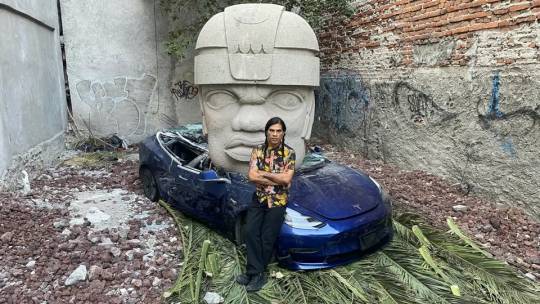
chavis mármol, "untitled destruction project," 2024,
nine-ton quarry stone replica of colossal olmec head dropped on blue tesla model 3
107 notes
·
View notes
Text

The unearthing of one of the 17 ancient colossal Olmec heads now located at the Museum of Anthropology in Xalapa.
📷 by @chicomoztoc_7_cuevas_
143 notes
·
View notes
Text

Chavis Mármol, "untitled destruction project," 2024, nine-ton quarry stone replica of colossal olmec head dropped on blue tesla model 3
87 notes
·
View notes
Text

The Olmec are considered one of the first great civilizations of Mesoamerica and developed mainly in what is today southeast Mexico, in the states of Veracruz and Tabasco. Its peak is between approximately 1200 BC and 400 BC. Some notable features of the Olmec civilization include:
1. **Art and Architecture**: They are famous for their colossal stone heads, some of which measure up to three meters tall and weigh several tons. These sculptures, along with other works of art, showcase a high level of skill and sophistication.
2. **Ceremonial Centers**: The Olmecs built large ceremonial centers, the most well-known are San Lorenzo, La Venta and Tres Zapotes. These sites included plazas, platforms and ceremonial mounds.
3. **Religion and Myths**: The Olmec religion was complex and centered around several deities, many of which were associated with nature, such as the jaguar, which was an important symbol. The Olmecs also developed rituals and practices that influenced later Mesoamerican cultures.
4. **Writing System and Calendar**: They are attributed to one of the earliest writing systems in Mesoamerica, although it has not been fully deciphered. They also developed a calendar, which was the basis for calendars of later civilizations such as the Mayans.
5. **Cultural Influence**: The Olmec civilization is considered a “mother culture” of Mesoamerica due to its influence on other pre-Columbian cultures, including the Mayans and Zapotecs. Their advances in agriculture, architecture and art laid the foundation for the development of these later civilizations.
In short, the Olmecs were a pioneering civilization in Mesoamerica, known for their monumental art, religion and mythology, and their lasting impact on the cultures that followed them.
13 notes
·
View notes
Text
At least the guy who crushed a Tesla with a giant concrete Olmec head was funny and the guy didn’t pay for the car
The art itself is not revolutionary but it’s cheeky and silly. Giant fuckin Olmec head outta nowhere
16 notes
·
View notes
Text

How about an Olmec Miku? :D
I read that the only animals domesticated by the Olmecs was the dog, so I tried drawing a dog, but I have no practice drawing dogs, so he looks like he's seen some shit </3 also idk how to draw boobs lol
I will also reupload Indus Valley Civilization Miku soon enough! I actually posted it and then deleted it because I was self-concious about the quality of my art... orz
Some more details under the cut
The Olmecs were the earliest big civilization in Mesoamerica, in what is nowadays Veracruz and Tabasco in Mexico. They existed around 1200 to 400 BC. They're best known internationally for their colossal head statues.
I don't have as detailed notes this time. I was inspired by Olmec art like these figures





as well as this statue of a woman:

I went for a more green color for her because the Olmecs made many pieces of Jade jewelry
This art by Daniel Parada was also a great source to help interpret the Olmec figures
I dont know how the Olmec's dogs would have looked like, so I drew one based on the Xoloitzcuintle, which is a Mesoamerican dog breed that's been around for a long long time.
As usual this was based on cursory internet searches so don't come to me for historical accuracy 😅 think of it as history-inspired.
#hatsune miku#vocaloid#international miku#miku worldwide#olmec#olmec miku#olmecs#mesoamerica#history#my art#stuff i made
43 notes
·
View notes
Text
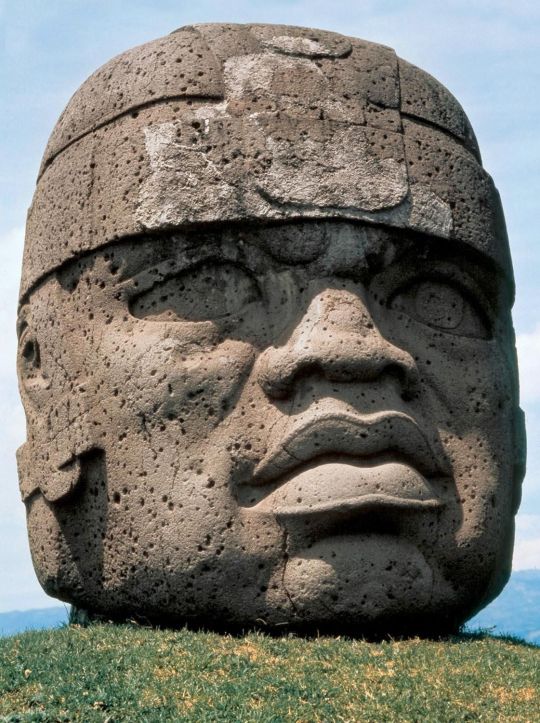
source: bishopsbox
One of the four colossal heads carved by Olmecs (800 BC). Heads measure up to 9 feet 4 inches (2.84 m) in height and weigh several tons, which causes a great deal of speculation on how the Olmecs were able to move them. Basalt quarry was found over 80 km away.
Una de las cuatro colosales cabezas talladas por los olmecas (800 AC). La cabeza mide 2,84 metros de altura y pesa varias toneladas, lo que provoca muchas especulaciones sobre cómo los olmecas fueron capaces de trasladarlas. La cantera de basalto fue encontrada a más de 80 kilómetros de distancia.
56 notes
·
View notes
Text
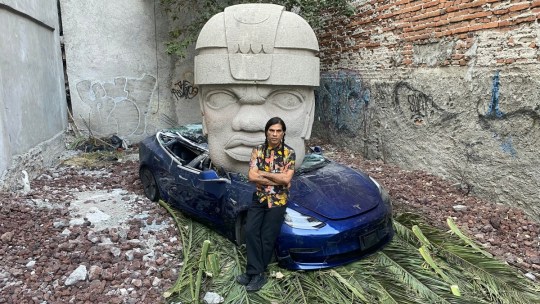
Artist Chavis Mármol dropped a nine-ton Olmec head made of quarry stone onto a blue Tesla Model 3
"Mármol cited the late artist Jimmie Durham’s piece “Still Life with Spirit and Xitle” (2007) as an inspiration for his performance. A satirical critique of the historical colonization and present-day corporatization of Mexico, Durham’s work consisted of the destruction of a 1992 Chrysler Spirit by way of dropping a smug-faced volcanic boulder onto the vehicle’s roof."

31 notes
·
View notes
Note
The olmec head hand boss from mario odyssey
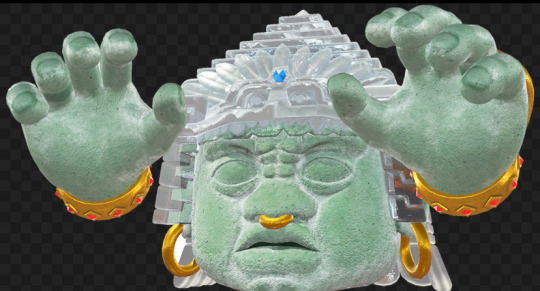
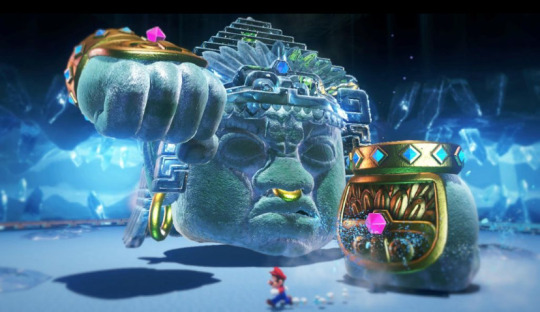
Knucklotec is the guardian deity and second boss of the Sand Kingdom in Super Mario Odyssey. Based on the real-world Olmec colossal heads
He is encountered when Mario reaches the Deepest Underground, just after completing the Underground Temple directly beneath the Inverted Pyramid. When Mario gets close enough, his hands fly in like rockets, and the head comes out of the ceiling to reach Mario's level. Knucklotec is distraught over the disappearance of the kingdom's Binding Band, and starts attacking Mario after erroneously assuming the latter to have stolen it, not realizing Bowser did beforehand.
He is the cause of the ice and low temperatures in the Sand Kingdom. When he is defeated, the majority of the ice melts away and the heat returns to normal
Reminder, the premise is “would a normie think it’s weird to find them attractive?” (Would they have to “hear me out?”) NOT “smash-or-pass”
#reblog for a bigger sample size#knucklotec#mario odyssey#super mario odyssey#super mario#Nintendo#hear me out#hearmeoutworthypoll#unconventionally attractive#down bad#why he kinda#poll#polls#tumblr polls
6 notes
·
View notes
Text
there should be an olmec colossal head emoji imagine the power
30 notes
·
View notes
Text

AU where Calmèque survived the destruction of the base along with Ménator, and other Olmecs (among which the Olmec lieutenant who wears the green cape, medics, the little guy in charge of maintaining the drainage tank, and other Olmec soldiers).
Ramblings about this AU below:
My headcanon is that Olmecs are sensitive to light (which is why they move or attack once night has fallen).
That's why they opted to build their new base in the heart of another mountain. There, they explored the most powerful energy source of all: nuclear fusion. In this way, they were able to reproduce on Earth the reactions that take place inside the sun, creating their own “sun”. I see Calmèque as one of the Olmecs with a more developed scientific mind and curiosity. While Ménator focuses on cellular biology to extend the Olmec's lifespan, Calmèque focuses on the study and understanding of high-temperature plasmas and their confinement by magnetic and electric fields.
A century later, the Olmecs created the first nuclear fusion reactor, generating colossal amounts of energy that satisfy their energy needs. Thanks to this, Ménator is able to electrically stimulate the fusion of two previously atrophied and dysfunctional Olmec reproductive cells (I headcanon the Olmecs as hermaphrodites, in which both reproductive systems progressively atrophied over time, hence the Olmecs are sterile). This way, they are able to ensure their descendants (although the embryos develop in incubating machines) and secretly become the most developed civilization on Earth :)
PS: to make Calmèque's outfit I was inspired by the clothes worn by the Olmecs in one of the new seasons (which I've never seen, but anyway).
17 notes
·
View notes
Text

Olmec colossal head (Monument 1), La Venta 1962 by Armando Salas.
9 notes
·
View notes
Text
Symbolism and Use of Red Pigments in Pre-Columbian Art
The use of red pigments and oxides in pre-Columbian art extends to various artifacts made of ceramics, textiles, stone, and wood, with each culture employing these materials in unique and meaningful ways. The Olmecs, Maya, Aztecs, Inca, Chancay, Wari, and Moche all utilized red pigments, reflecting a blend of symbolic, aesthetic, and practical considerations.
The Olmecs
The Olmec civilization, one of the earliest Mesoamerican cultures, used red pigments, particularly hematite (iron oxide), to color their monumental stone sculptures and ceramics. The red color, often associated with life, vitality, and the sacred, enhanced the spiritual significance of their art. Hematite was ground into a fine powder and mixed with other materials to create a durable paint that adorned their colossal heads and intricate carvings.
The Maya
The Maya civilization, renowned for its complex iconography and vibrant murals, extensively employed red pigments derived from hematite and cinnabar (mercury sulfide). The Maya used these pigments on stone stelae, murals, ceramics, and codices. Red symbolized blood and the life force, often used to depict deities, rituals, and elite figures. The pigments’ durability ensured their elaborate designs remained striking over centuries, preserving the rich detail of their carvings and inscriptions.
The Aztecs
The Aztecs, who followed the Maya in Mesoamerica, also used red pigments in codices, stone sculptures, and ceremonial wooden objects. The Aztecs symbolized life and death with red, closely linking it to the blood sacrifices central to their religious practices. Red was applied to carved stone reliefs and wooden ceremonial masks, emphasizing essential figures and events in Aztec history and mythology. These pigments highlighted intricate details, adding depth and dimension to their art.
The Moche
The Moche culture of northern Peru, renowned for its realistic and expressive ceramics, utilized red pigments to accentuate details in their pottery, stone carvings, and wooden objects. Red in Moche art often highlighted human figures, animals, and scenes from mythology, providing a vivid contrast that brought their depictions to life. Iron oxide pigments ensured the durability and vibrancy of their ceramic and carved artwork.
The Wari
The Wari culture, or Huari, preceded the Inca in the Andean highlands and used red pigments extensively. Wari textiles, known for their complex iconography, featured red dyes derived from cochineal insects and other natural sources. Stone sculptures and wooden artifacts, including ceremonial bowls and masks, were painted red to highlight religious and social symbols, underscoring the cultural significance of the artifacts.
The Chancay
The Chancay culture of the central coast of Peru, known for its distinctive ceramics and textiles, employed red pigments to decorate their pottery and woven goods. They also used red pigments on wooden artifacts, such as ceremonial staffs and figurines. Red in Chancay art created geometric patterns and symbolic motifs, reflecting their cosmological beliefs and societal structure.
The Inca
In South America, the Inca civilization utilized red pigments in their textiles, ceramics, stonework, and wooden artifacts. The Inca sourced red pigments from iron oxides and plant-based dyes to create intricate patterns and designs that conveyed social status, cosmology, and religious beliefs. Stone structures, such as the famous Inca walls, occasionally featured red-painted carvings. Wooden artifacts, including ceremonial objects and tools, were adorned with red pigments to signify their importance and connection to the divine.
Conclusion
In conclusion, red pigments in pre-Columbian art were widespread across various cultures and materials, each with unique applications and symbolic meanings. Red pigments were integral to expressing cultural values, religious beliefs, and artistic traditions from the Olmecs and Maya in Mesoamerica to the Inca, Chancay, Wari, and Moche in the Andes. The durability and vividness of red pigments made them a favored choice for creating art that has withstood the test of time, allowing us to appreciate the rich heritage of these ancient civilizations. Their application on ceramics, textiles, stone, and wood artifacts further highlights the versatility and importance of red pigments in pre-Columbian art.
Olmec Green Stone Masks: Symbolism and Ritual Significance
Research Academic Papers and News Articles
#ancient art#ancient history#archaeology#pre-columbian#art history#inca#artifacts#aztec#mayan#south america#olmec
8 notes
·
View notes